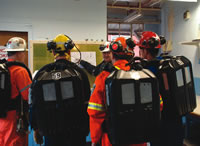 As mining companies in Canada and around the world follow their orebodies to depth, one of the challenges they have to deal with is the effect of higher and higher temperatures on workers.
As mining companies in Canada and around the world follow their orebodies to depth, one of the challenges they have to deal with is the effect of higher and higher temperatures on workers.
Rock temperatures in an underground mine 7,000 to 10,000 feet below surface can reach a blistering 45 degrees Celsius, and while air temperatures are somewhat moderated by ventilation, heat stress is still a major issue.
Research on the effect of heat and physical exertion on miners has been lacking, but a pioneering study undertaken by the Sudbury-based Deep Mining Research Consortium will provide the industry with a better understanding of the problem and produce protocols and policies to mitigate the risk of heat stress, claims Cheryl Allen, a senior ventilation engineer at Vale Inco’s Sudbury operations.
Researchers from the University of Ottawa’s Department of Human Kinetics went underground at Agnico-Eagle’s 10,170-foot (3,100 metres) deep La Ronde Mine in Quebec’s Abitibi region to videotape miners and record their temperatures.
Time motion analyses
“They looked at 10 to 12 typical tasks such as walking, bolting, drilling and mucking,” said Allen. “They did in situ time motion analyses, and fitted the miners with instruments to measure their body temperatures at various places – including skin and ear temperatures. They even swallowed temperature sensing pills.”
The objective was to gain a better understanding of the energy expended for each task and how long miners can work before they are at risk of overheating.
This summer, additional research was conducted at Vale Inco’s Garson Mine in Sudbury to measure the energy expended by a mine rescue team engaged in more strenuous activity.
Lacking precise scientific data, mining companies have until now relied on cranking up the ventilation and cautioning workers to pace themselves, take frequent breaks and make sure they are well hydrated.
“We do a lot of training and education,” said Allen. “It’s so important that you come to work well-rested and hydrated. And it’s not enough to just drink coffee. You have to drink water.”
Vale Inco doesn’t tell workers exactly how often to take breaks because people react to heat differently.
“People who have diabetes or high blood pressure don’t respond to heat very well,” explained Allen. “Females don’t handle heat as well as males. Age and physical fitness also make a big difference. If you’re fit, you’ll be able to handle heat a lot better, so there are a lot of things we have to look at.”
The symptoms of heat stress can include headaches, dizziness and feeling tired. In more severe cases, people suffering from heat stress can become disoriented or pass out.
Mining companies also mitigate heat by using loaders, jumbos and trucks with enclosed, air conditioned cabs and installing air conditioning in lunchrooms, “but there will always be jobs where you’re out in the heat and working hard,” said Allen. “Those are the ones we worry about.”
Refrigeration
Agnico-Eagle uses surface refrigeration at La Ronde to cool the air that’s sent underground, but that’s an expensive option. Vale Inco is fortunate to have a natural cooling solution at Creighton Mine thanks to an adjacent open pit that fills with snow and ice during the winter. Air pumped underground descends through a mass of rock kept cool by the accumulated snow. The rock absorbs the heat from the air and cools it to a temperature of three or four degrees Celsius, but the rock only stays cool until August.
“As it goes underground, it heats up again because the air compresses and there’s friction on the walls of the raises, so at the 8,000-foot level, it’s already heated up,” said Allen. “At some point, we may have to make a decision about recooling the air. We’re not there yet, but we’re getting close.”
The use of diesel equipment underground is another factor contributing to the heat in deep mines.
“If we didn’t have diesel, we could go much deeper before we would have to cool the air,” said Allen.
Researchers at the University of Ottawa have expressed an interest in developing instrumentation that miners could wear to alert them to the onset of heat stress, but whether they can come up with something miners will tolerate is yet to be determined.
At the very least, said Allen, mining companies will have a better understanding of the energy output and the risks associated with each task and, armed with this information, they will be able to fine-tune their procedures and protocols for miners working at depth.
The study is scheduled to be completed before the end of the year. Members of the Deep Mining Research Consortium include Agnico Eagle, Barrick Gold, Vale Inco, Xstrata, Rio Tinto, CANMET and the City of Greater Sudbury.


